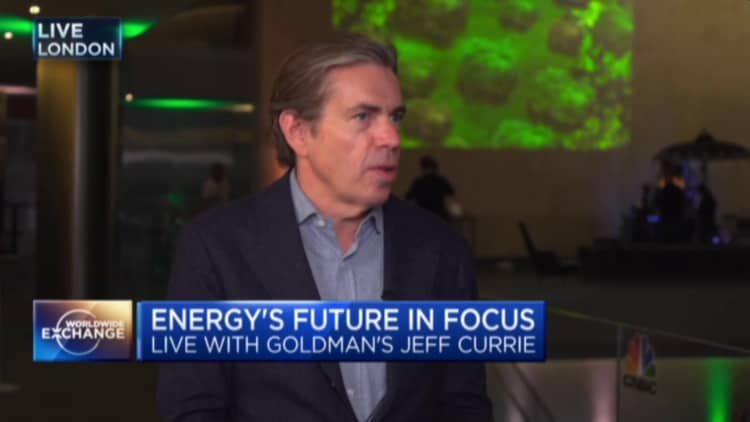
OPEC+, a group of 23 oil-producing nations led by Saudi Arabia and Russia, will convene on Sunday to decide on the next phase of production policy.
Bloomberg | Bloomberg | Getty Images
OPEC and non-OPEC oil producers could impose deeper oil output cuts on Sunday, energy analysts said, as the influential energy alliance weighs the impact of a pending ban on Russia’s crude exports and a possible price cap on Russian oil.
OPEC+, a group of 23 oil-producing nations led by Saudi Arabia and Russia, will convene on Sunday to decide on the next phase of production policy.
The highly anticipated meeting comes ahead of potentially disruptive sanctions on Russian oil, weakening crude demand in China and mounting fears of a recession.
Claudio Galimberti, senior vice president of analysis at energy consultancy Rystad, told CNBC from OPEC’s headquarters in Vienna, Austria, that he believes the group “would be better off to stay the course” and roll over existing production policy.
“OPEC+ has been rumored to consider a cut on the basis of demand weakness, specifically in China, over the past few days. Yet, China’s traffic nationwide is not down dramatically,” Galimberti said.

Energy market participants remain wary about the European Union’s sanctions on the purchases of the Kremlin’s seaborne crude exports on Dec. 5, while the prospect of a G-7 price cap on Russian oil is another source of uncertainty.
The 27-nation EU bloc agreed in June to ban the purchase of Russian seaborne crude from Dec. 5 as part of a concerted effort to curtail the Kremlin’s war chest following Moscow’s invasion of Ukraine.
Concern that an outright ban on Russian crude imports could send oil prices soaring, however, prompted the G-7 to consider a price cap on the amount it will pay for Russian oil.
No formal agreement has yet been reached, although Reuters reported Thursday that EU governments had tentatively agreed to a $60 barrel price cap on Russian seaborne oil.
“The other factor OPEC will need to consider is indeed the price cap,” Galimberti said. “It’s still up in the air, and this adds to the uncertainty.”
The Kremlin has previously warned that any attempt to impose a price cap on Russian oil will cause more harm than good.
‘So much uncertainty’
OPEC+ agreed in early October to reduce production by 2 million barrels per day from November. It came despite calls from the U.S. for OPEC+ to pump more to lower fuel prices and help the global economy.
The energy alliance recently hinted it could impose deeper output cuts to spur a recovery in crude prices. This signal came despite a report from The Wall Street Journal suggesting an output increase of 500,000 barrels per day was under discussion for Sunday.
OPEC+ agreed in early October to reduce production by 2 million barrels per day from November. It came despite calls from the U.S. for OPEC+ to pump more to lower fuel prices and help the global economy.
Bloomberg | Bloomberg | Getty Images
Speaking earlier this week, RBC Capital Markets’ Helima Croft said there was no expectation of a production increase from the upcoming OPEC+ meeting and a “significant chance” of a deeper output cut.
“There is so much uncertainty,” Croft told CNBC’s “Squawk Box” on Tuesday. OPEC delegates “have to factor in what happens with China but also what happens with Russian production.”
“My expectation right now is, if prices are flirting with Brent breaking into the 70s, certainly OPEC will do a deeper cut, but the question is, how do they factor in what is going to come the next day?” Croft said. “So, I still think it is up for grabs.”
Oil prices, which have fallen sharply in recent months, were trading slightly lower ahead of the meeting.
International Brent crude futures traded 0.2% lower at $87.78 a barrel on Friday morning in London, down from over $123 in early June. U.S. West Texas Intermediate futures, meanwhile, dipped 0.3% to trade at $80.95, compared to a level of $122 six months ago.

“Barring any negative surprise during Sunday’s virtual OPEC+ talks and assuming a healthy compromise on Russian oil price cap before the EU sanctions kick in on Monday it is tempting to audaciously conclude that the bottom has been found,” Tamas Varga, analyst at broker PVM Oil Associates, said in a note Thursday.
Varga said oil prices trading below $90 a barrel was “not acceptable” for OPEC and Russia was widely expected to introduce retaliatory measures against those signing up for the G-7 deal.
“Choppy and nervous market conditions will prevail, but the new month should bring more joy than November,” he added.
‘High probability’ of an output cut
Jeff Currie, global head of commodities at Goldman Sachs, said OPEC ministers would need to discuss whether to accommodate further weakness in demand in China.
“They got to deal with the fact that, hey, demand is down in China, prices are reflecting it, and do they accommodate that weakness in demand?” Currie told CNBC’s Steve Sedgwick on Tuesday.
“I think there is a high probability that we do see a cut,” he added.
Analysts at political risk consultancy Eurasia Group said that lower oil prices “heighten the risk” of a new OPEC+ output cut.
“Ultimately, the decision will depend on the trajectory of the oil price when OPEC+ meets and how much disruption is evident in markets because of the EU sanctions,” Eurasia Group analysts led by Raad Alkadiri said Monday in a research note.
If Brent crude futures dip below $80 a barrel for a sustained period ahead of the meeting, Eurasia Group said OPEC+ leaders could push for another production cut to shore up prices and bring Brent futures back up to around $90 — a level “that they appear to favor.”
